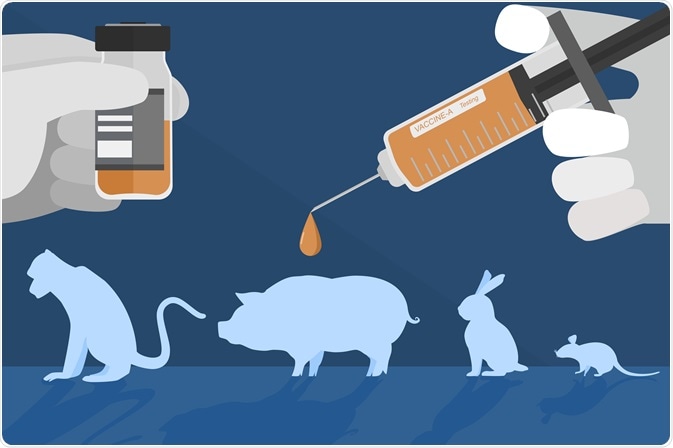Preclinical testing is vital for assessing the safety profiles and potential efficacy of new therapeutics in development. Animal testing is one of two routes usually selected for the preclinical stage, the other being testing on human cell cultures in vitro.
While scientists must provide a sound rationale for choosing the animal model over the in vitro methodology to ensure that animal models are used only when absolutely necessary, the topic of the ethics of using animal models at all in preclinical testing remains hotly debated. Here, we will discuss this theme in depth, and conclude on the current stance taken by the scientific community.
 Image Credit: Hugethank / Shutterstock.com
Image Credit: Hugethank / Shutterstock.com
The question of sentience in animals underpins ethical debate
Currently, laws and policies that regulate the use of animal subjects in scientific and medical testing focus on attempting to strike a balance between the benefit of gaining knowledge and any pain or suffering caused to the animals used in testing. However, the process of finding a balance is not simple. This is mostly because people do not agree on the value of the benefit, nor the cost of the suffering.
Medical science is driven, at least in part, by a need to continue to develop our therapeutic offerings to the vast number of diseases that inflict humans, in order to improve our quality of life and longevity. This need to develop new pharmaceuticals is not disputed. However, the process whereby this end is achieved is debated. Is causing the suffering of one species ethically acceptable if it alleviates the suffering of another?
In Europe, animal testing is considered to be ethically acceptable only in cases where the knowledge that could potentially be gained by this kind of experimentation is viewed to weigh up against the suffering caused. But how does one measure suffering? And how does one measure the value of information yet to be revealed?
Performing the balancing act of assessing the ethics of preclinical testing using animal subjects is, therefore, complicated. However, the center of the debate often falls on the same question. Should animals be treated as moral subjects?
While the use of animal models in modern preclinical studies considers the health and wellbeing of the animals, it only does this because it correlates with human interests - that healthy animals can benefit the course of the research. Considering animals as having moral status implies that we have direct duties towards them. If we consider animals as moral subjects then the balancing act becomes even harder, as it would suggest that it is morally wrong to take the life of an animal no matter what benefit it provided to human lives.
It also suggests that it is our duty to prevent the suffering of all animals (including humans), equally. The question of whether animals should be treated as moral subjects often leads to the discussion of what criteria must an animal meet in order to be considered as having moral standing. Sentience, the ability to suffer, and higher cognitive abilities are often considered as necessary criteria for being considered an animal deserving of moral standing.
However, others argue that regardless of these factors, humans have no moral obligations to other species as they have superiority above all. This concept is referred to as ‘speciesism’. Those who support the notion that humanity should benefit no matter what to cost to other species argue that humankind’s elevated levels of rationality, communication, and self-awareness deserve this stance of superiority. However, those opposed to this concept counter this argument by highlighting that the reduced rationality, communication, and self-awareness of some populations of humans, such as babies, does not disqualify them from having moral standing, and, therefore, no other species should be disqualified in this way.
Could technology end animal testing?
While the opinions of those in the scientific community vary greatly in terms of whether the testing on animals is ethical in preclinical testing, there has been a general acceptance of the idea that a balance must be struck and that animal testing should be avoided unless it is absolutely necessary for the further development of a potentially life-saving or quality of life-enhancing drug/vaccine.
This need for balance has resulted in the call for scientists to provide a sound argument for the use of animals. They must demonstrate that the benefits of testing on animals, such as facilitating the development of a new pharmaceutical with the potential to significantly improve quality of life for a large number of people, outweigh the drawbacks, such as the distress and harm caused to the living creatures to be tested on in the suggested preclinical study.
In the future, it is likely that animal testing will become less common in preclinical testing as technology develops. For example, newly emerging technology such as organ-on-a-chip (OOC) and advanced computer modeling may provide avenues to preclinical testing that allow scientists to predict how the human body will respond to pharmaceuticals and certain chemical compounds without introducing them to a living human or animal.
Note: This article is aimed to provide an objective overview of scientific regulations on animal use in preclinical testing for informative purposes and does not necessarily represent the opinions of NewsMedical.
Sources
- Denayer, T., Stöhr, T. and Roy, M., 2014. Animal models in translational medicine: Validation and prediction. European Journal of Molecular & Clinical Medicine, 2(1), p.5. https://www.sciencedirect.com/science/article/pii/S2307502314000022
- Jans, V., Dondorp, W., Goossens, E., Mertes, H., Pennings, G. and de Wert, G., 2018. Balancing animal welfare and assisted reproduction: ethics of preclinical animal research for testing new reproductive technologies. Medicine, Health Care and Philosophy, 21(4), pp.537-545. https://pubmed.ncbi.nlm.nih.gov/29417302/
- Low, L., Mummery, C., Berridge, B., Austin, C. and Tagle, D., 2020. Organs-on-chips: into the next decade. Nature Reviews Drug Discovery,. https://www.nature.com/articles/s41573-020-0079-3
- Varga, O., Hansen, A., Sandøe, P. and Olsson, I., 2010. Validating Animal Models for Preclinical Research: A Scientific and Ethical Discussion. Alternatives to Laboratory Animals, 38(3), pp.245-248. https://pubmed.ncbi.nlm.nih.gov/20602541/
Further Reading